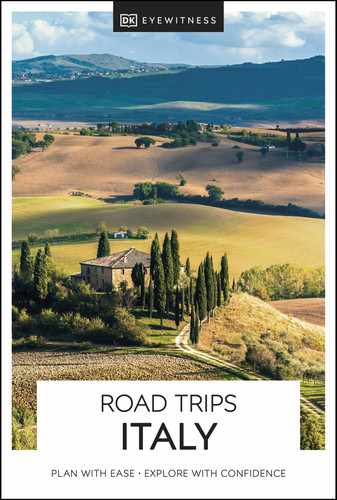Noto is the apogee of Sicilian Baroque and its newly restored centre is as perfect as a stage set. Much of Noto’s charm lies in the local limestone from which it is built, the hues varying from gold to apricot ice cream depending on the light. Unfortunately, this stone is also friable (and thus fragile), leaving the city vulnerable to the quakes and tremors to which the region is prone. In 1996 the dome of the cathedral collapsed and the restoration, painstakingly undertaken stone by stone, has recently been completed.
Work began on Noto in 1703, ten years after the original town – now known as Noto Antica – was destroyed by the earthquake. To see the best of the town, walk along the main street, Corso Vittorio Emanuele, passing through the imposing Porta Reale. On the left is the church of Santa Chiara (open daily), built on an unusual elliptical plan, and beyond, the theatrical central square, Piazza Municipio, where a magnificent flight of steps rises to the muscular Baroque Duomo (open daily), its interior serene and flooded with light from the rebuilt dome. Opposite the Duomo, is the elegant Palazzo Ducezio, Noto’s town hall. Walk alongside the Duomo to Palazzo Trigona, with its curvaceous balconies, where steps lead up past more fine Baroque buildings to Noto Alta, the upper town, and the church of Santa Maria di Gesù (rarely open to the public), from where there are views of the surrounding countryside.
 Follow signs for Siracusa, then Siracusa/Pachino on the SP15. Right on the SP19 for Pachino, following signs for Portapalo. Look for sign for Cala Mosche on the walls. Slow for sharp left turn.
Follow signs for Siracusa, then Siracusa/Pachino on the SP15. Right on the SP19 for Pachino, following signs for Portapalo. Look for sign for Cala Mosche on the walls. Slow for sharp left turn.
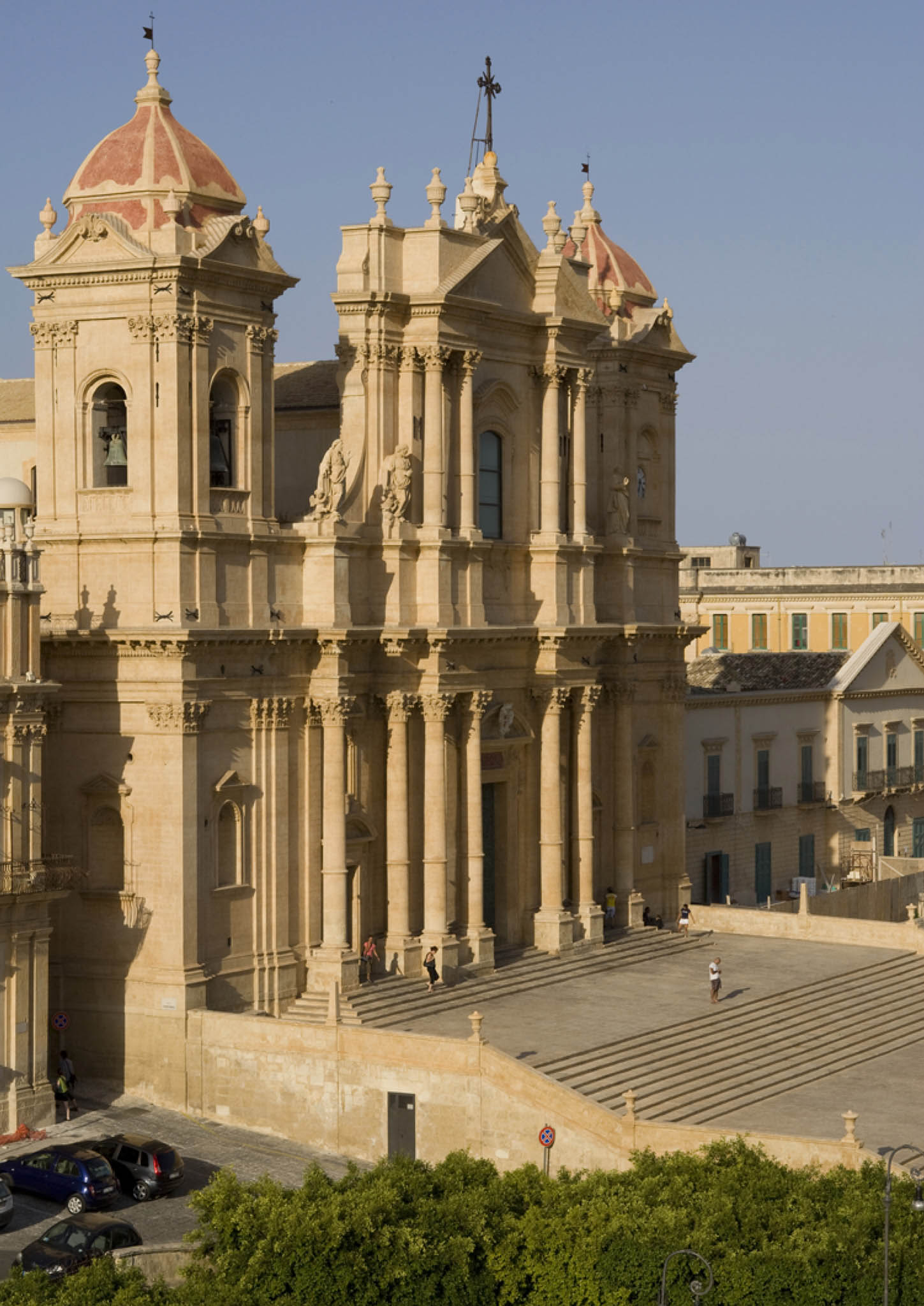
The façade of the restored Duomo in Noto, glowing in the evening light

Arcaded and balconied stone façade of the Palazzo Ducezio, Noto
This enchanting coastal nature reserve has well-marked paths to unspoiled beaches of white-gold sand, and a chain of salt lakes that between October and March attract over 200 species of migratory birds, including flamingoes, herons, cranes, black storks and pelicans.
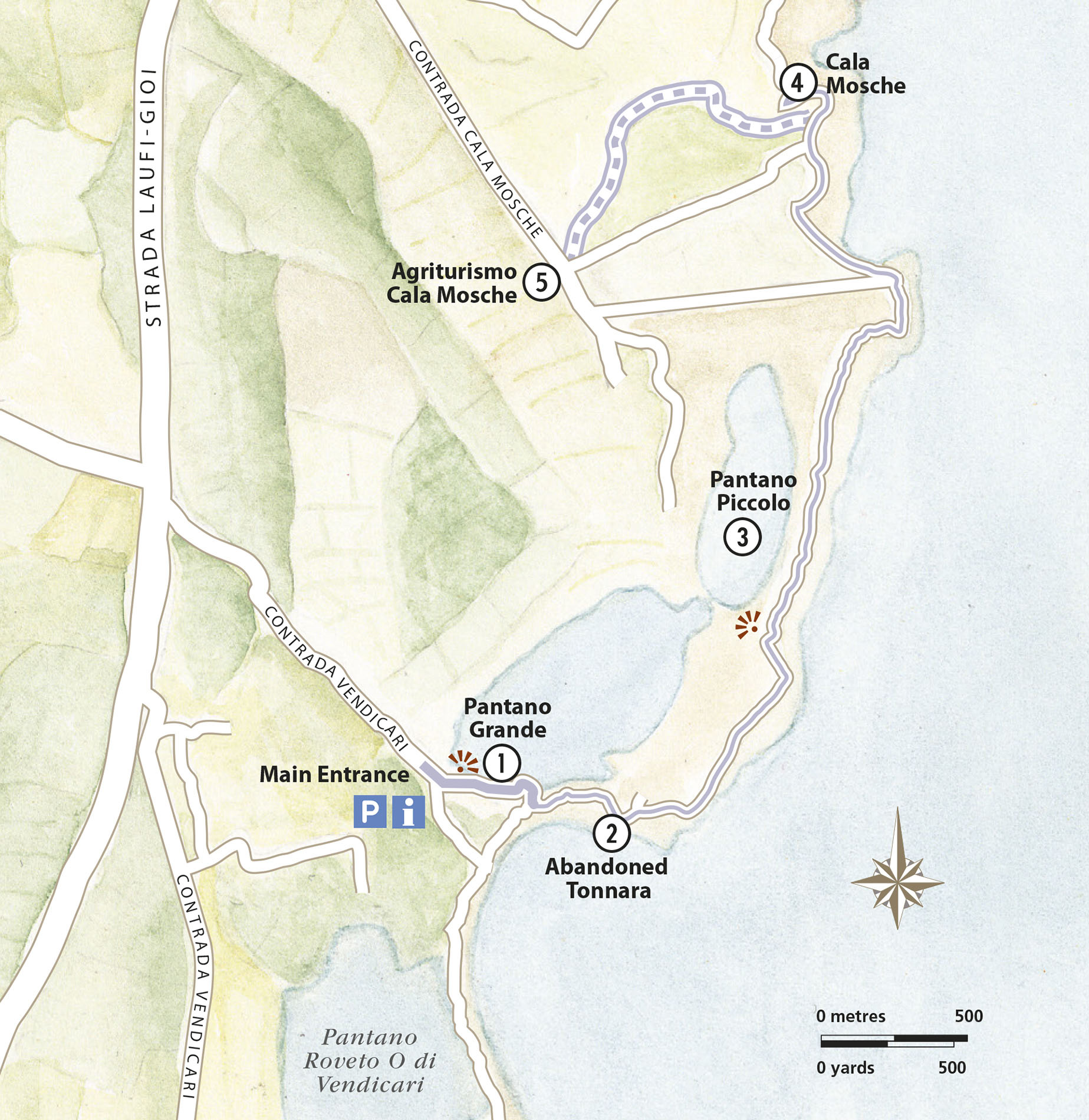
n Double-tap image to read the labels
A one-hour walking tour
Leave the main car park, turn left. Visitors can pick up free large scale maps from the information booth. Follow the path straight ahead, stopping off to observe the birds on the Pantano Grande 1 lake from the hide on the left. The path continues along duckboards through a forest of bamboo down to the coast, emerging on a fine beach of pale gold sand dominated by the ruins of an abandoned tonnara 2, or tuna processing plant, dating back to the 1920s and built by the Florio family, who invented canned tuna. The lakes were used to provide salt for the preserving of tuna.
The path then follows the coast, with more views over Pantano Grande, and its smaller sister lake, Pantano Piccolo 3, to the stunning cliff-hugged bay of Cala Mosche 4, one of the most beautiful bays in Sicily and a popular location for film shoots. Until recently, turtles would nest on the beaches, but local fondness for turtle soup led to their disappearance. Projects are underway to encourage the turtles back to Vendicari. From here the walk can be extended to take in the Agriturismo Cala Mosche 5, about 1 km (half a mile) away along a clearly marked path across typical Mediterranean maquis.
 Continue on the SP19 following the brown signs for Marzamemi. Parking is available on both sides of the town.
Continue on the SP19 following the brown signs for Marzamemi. Parking is available on both sides of the town.
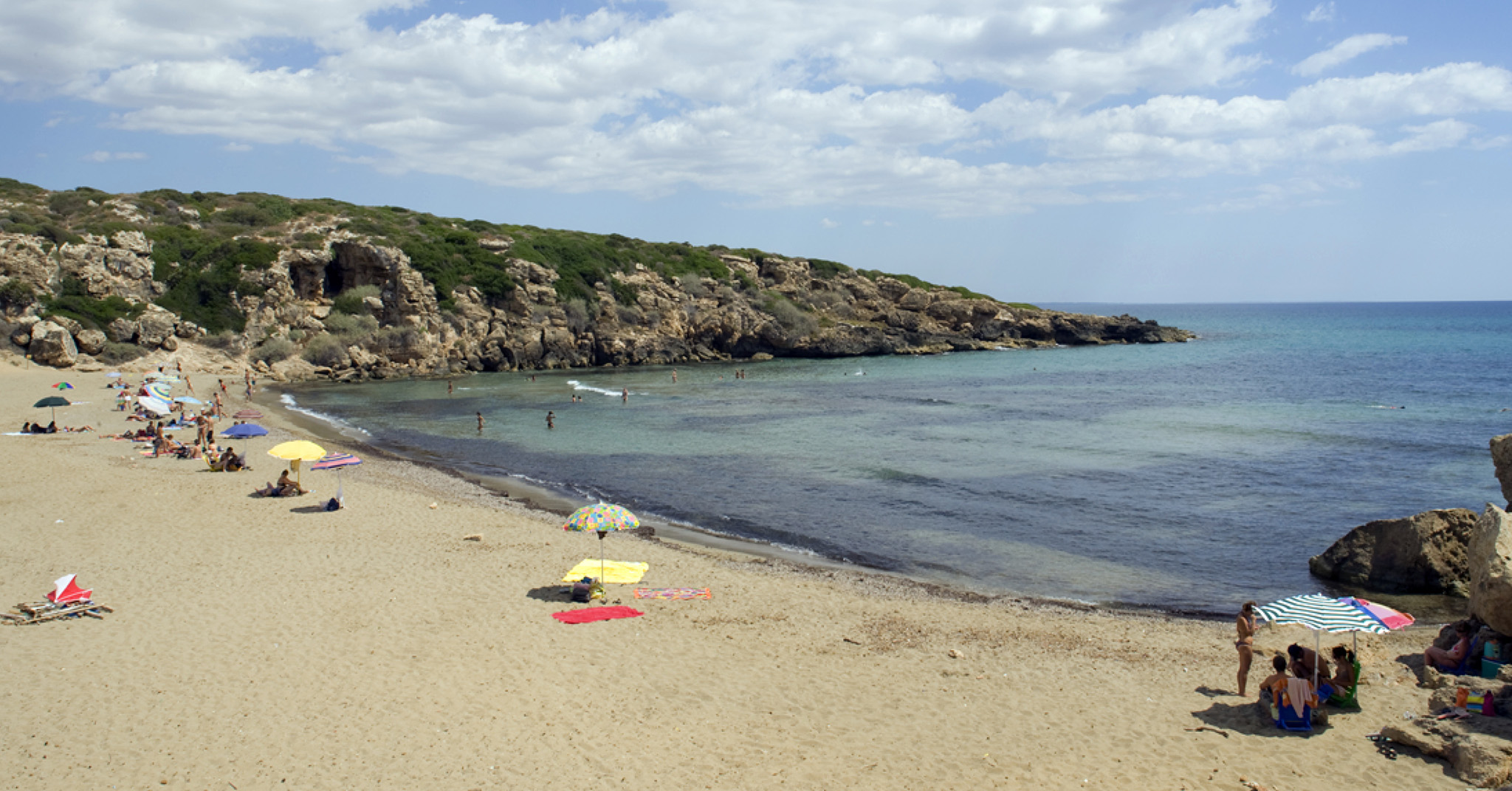
Cala Mosche beach and bay, Riserva Vendicari

Conehead thyme, a typical maquis plant found at Riserva Vendicari
Trip 22: Sicilian Baroque | RISERVA NATURALE L’OASI DI VENDICARI
Maquis flora
Among the typical plants of the Mediterranean maquis to look out for are species such as Juniperus macrocarpa, a rare type of juniper bush, and Coridothymus capitatus, or conehead thyme, whose nectar is the prime ingredient in Hyblaean honey, renowned since antiquity.
Once an important centre for tuna fishing, Marzamemi retains an evocatively decayed maritime complex of 19th- and early 20th-century tuna factory, warehouses and a lichened church, all built of mellow local limestone. A tonnara at nearby Pachino houses La Cialoma restaurant, owned by the niece of the last rais, a name for the head tuna fisherman that goes back to Arab times. “La Cialoma” was the song traditionally sung to round fishermen up for the mattanza, or tuna slaughter, held in May and June, when tuna were trapped in a complex system of nets, before being stabbed to death.
 Follow signs for Pachino. Left on SR6, cross SR8, right to Capo delle Correnti.
Follow signs for Pachino. Left on SR6, cross SR8, right to Capo delle Correnti.

Remnants of the old tuna factory and church in Marzamemi’s old town
Trip 22: Sicilian Baroque | NOTO
Visiting Noto
Parking
Follow signs for Centro Storico, and park on the road to Largo Porta Nazionale.
Trip 22: Sicilian Baroque | RISERVA NATURALE L’OASI DI VENDICARI
Visiting Riserva naturale l’oasi di Vendicari
Main entrance and information point at Pantano Grande. Entry to park is free but there is a small fee for parking. Open daily 7am–8pm (summer) or 6:30pm (winter)
Trip 22: Sicilian Baroque | NOTO
WHERE TO STAY
noto
La Fontanella moderate
This restored 19th-century palazzo on the edge of the old town has 9 rooms and 4 suites. Via Rosolino Pilo 3, 96017; 0931 894 724; www.albergolafontanella.it; closed Jan–Mar
Trip 22: Sicilian Baroque | NOTO
EAT AND DRINK
Noto
Costanzo inexpensive
One of the most famous gelaterie (ice cream parlours) in Sicily, with flavours such as jasmine and rose evoking the island’s Arabic heritage. Via Spaventa 7, behind Palazzo Ducezio, 96017; 0931 835 243; closed Wed
riserva naturale l’oasi di VENDICARI
Agriturismo Cala Mosche inexpensive
This holiday farm house produces its own vegetables, lemons and oil. Food in its restaurant includes local cheese, fish and game. Rooms available. Cala Mosche entrance, 96017; 347 858 7319; closed Nov–Mar
AROUND Marzamemi
L’Alimentare Scimonello
Pachino tomatoes are famous and it is worth stopping at this grocery shop to buy sundried tomatoes, local chillies, pine nuts, almonds and dried fruit. Piazza Vittorio Emanuele, 96018, Pachino (4 km/2 miles from Marzamemi), 96018; 0931 846 305; closed Sun
La Cialoma inexpensive
Set in a picturesque old tonnara and run by the niece of the last rais, this restaurant specializes in fresh local fish. Piazza Regina Margherita 23, Pachino, 96018; 0931 841 772; closed Tue pm
This is the southernmost tip of Sicily, further south than Tunis and Algiers. There are high winds and dramatic seascapes to be seen at this meeting point between the Ionian Sea and the Canale di Sicilia, but in calm weather and at low tide it is possible to wade across a sunken isthmus to the Isola delle Correnti just offshore.
 Take SR6 towards Noto. Left on SP22, becoming SP49, follow signs to Ispica.
Take SR6 towards Noto. Left on SP22, becoming SP49, follow signs to Ispica.
The hill town of Ispica retains a small Baroque core, worth visiting for the elliptical Piazza Santa Maria Maggiore, concealed within a maze of modern houses, and for the splendid Art Nouveau exterior of the Palazzo Bruno di Belmonte, seat of the local council, (open daily), currently undergoing restoration. Ispica lies at the head of a limestone gorge honeycombed with rock-cut tombs and dwellings. The part of the gorge nearest to Ispica is organized as the Parco Archeologico della Forza (open daily, 9am–1hr before sunset ), with a well-marked path that takes in ancient cave dwellings, catacombs converted into stables and cave churches. The caves were inhabited up until the earthquake of 1693 and a flight of 3,300 steps, now eroded, would have been used to fetch water from the valley.
 Take SS115 towards Modica, right on SS43. Follow signs for Modica Centro, park at the end of Via Medaglie d’Oro.
Take SS115 towards Modica, right on SS43. Follow signs for Modica Centro, park at the end of Via Medaglie d’Oro.

Colonnade of the elliptical Piazza Santa Maria Maggiore, Ispica
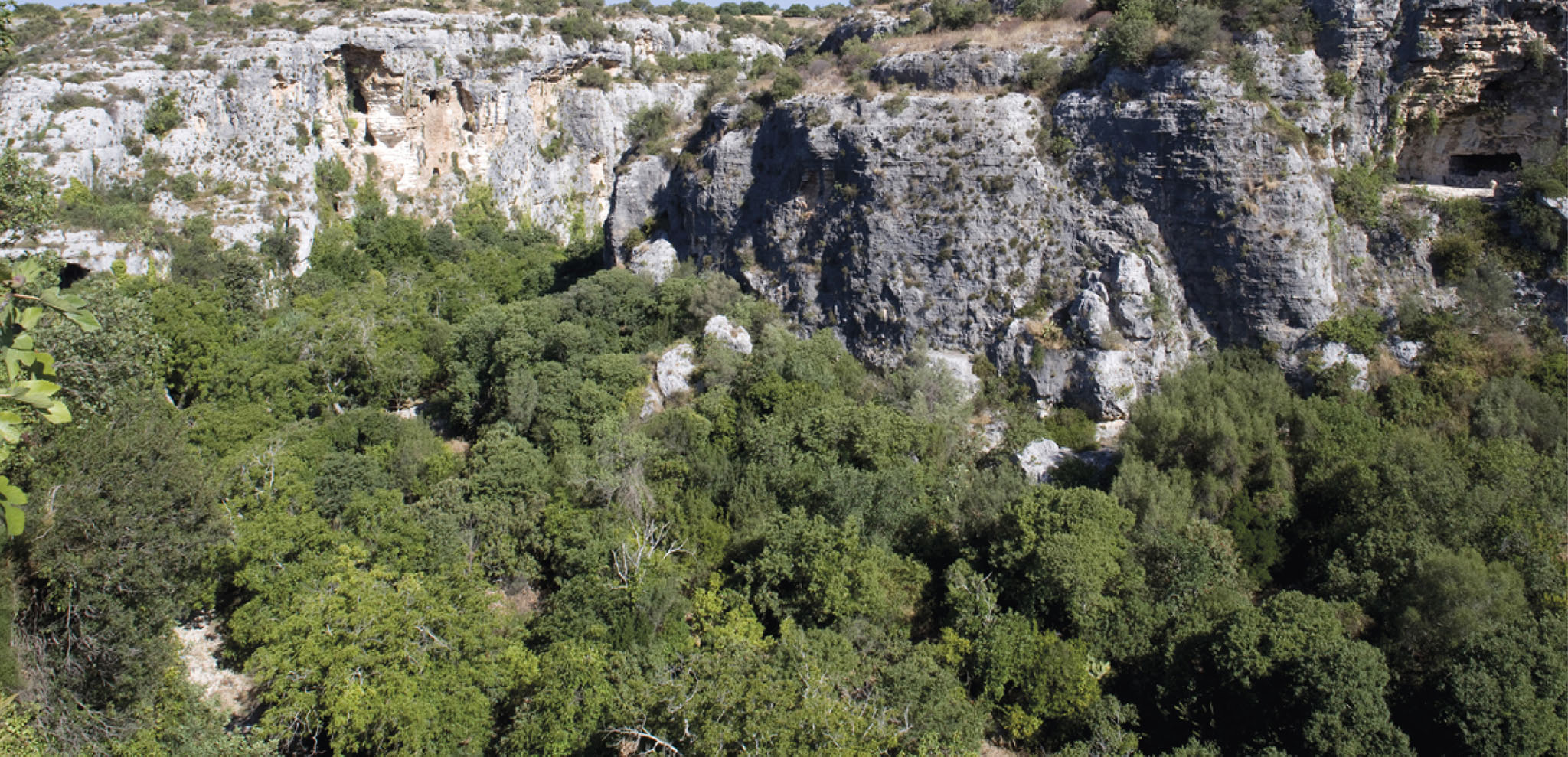
Caves perforate the cliff face of the gorge, Parco Archeologico della Forza
This fine, thriving Baroque town is as famous for its chocolate as for its architecture. Wander along the main street, Corso Umberto I, where the best places to sample Modica’s traditional “glass chocolate” are Caffè dell’Arte and Bonajuto. Ask to see a video of a Bonajuto TV advert, in which an American pilot, suspended from a tree by his parachute, tries to persuade a little girl to run for help, with the offer of a Hershey bar. She shakes her head, and silently shows him her bar of Bonajuto.
Of Modica’s sights, the most spectacular is the mighty church of San Giorgio (open daily) by Baroque genius Rosario Gagliardi, at the head of a flight of 250 steps. The church of San Pietro (open daily) just off Corso Umberto I, is approached up another magnificent flight of steps, punctuated by statues of the Apostles. Easter celebrations in Modica culminate in the Vasa Vasa, when a statue of the Madonna in mourning searches for her lost Son; upon meeting the resurrected Christ she kisses him (vasa means kiss in Sicilian) and sheds her black veil.
 Follow signs to Scicli on SS54. Park by main square Largo Gramsci.
Follow signs to Scicli on SS54. Park by main square Largo Gramsci.
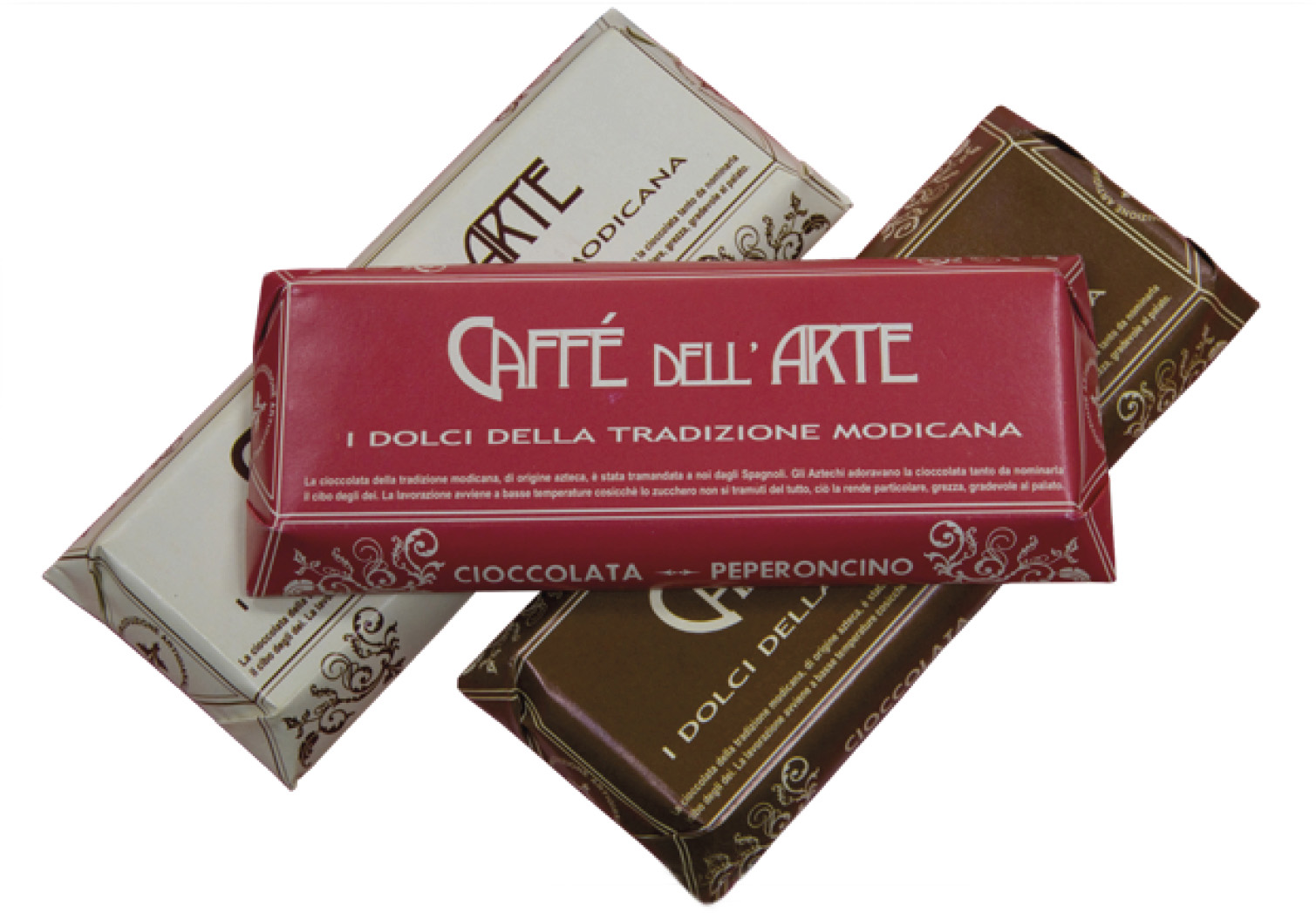
Chocolate bars, Modica
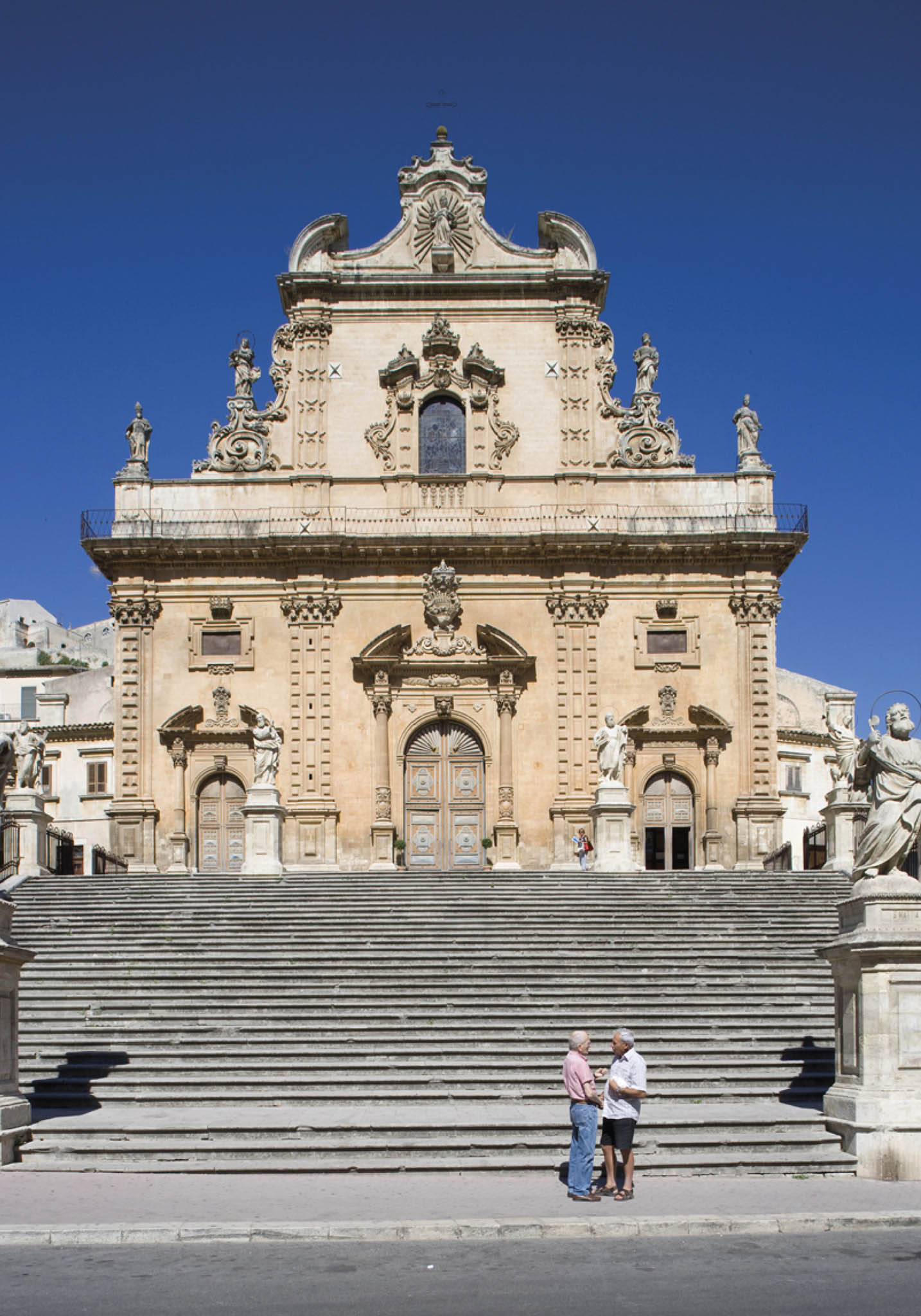
Stairs lead past statues of the Apostles to the church of San Pietro, Modica

Roofscape of the old town, Modica
Trip 22: Sicilian Baroque | MODICA
Glass Chocolate
The art of making chocolate was introduced to Sicily by the Spanish, who in turn had learned from the Aztecs of Central America in the 16th century. The chocolate of Modica is still made in this way, with only pure cocoa and sugar, and without the use of heat or cocoa butter, so that it has a crunchy, grainy texture that has led it to be known as cioccolato di vetro, or glass chocolate.
An appealing Baroque town spilling along three river valleys dominated by soaring limestone cliffs, where life is typically Sicilian: the pace is slow, men in suits and caps converse for hours outside circoli (small clubs), talking politics over a glass of local wine. Scicli is home to the Gruppo di Scicli of contemporary artists who are opposed to the trend for conceptual art, favouring instead an authentic response to the landscape and people around them.
Take a wander down Via Mormino Penna, lined with Baroque churches and palaces, and visit the curvaceous church of San Bartolomeo (open daily). Do not miss the monster-adorned balconies of Palazzo Beneventano, just down the street from San Bartolomeo. A short drive out of town are the remains of the 11th-century church of San Matteo and castle, fused to the cliff tops. The castle was built by the Saracens and this period of Arabic rule is recalled in the festival of Madonna delle Milizie in May, which re-enacts a battle between Saracens and Normans, won by the Normans with the help of the Madonna. Another remarkable event is the Cavalcata di San Giuseppe, held on the Saturday nearest to 19 March, when horses, astonishingly decorated with flowers, follow the Holy Family in a candlelit procession.
 Follow signs to Sampieri on the SS40.
Follow signs to Sampieri on the SS40.
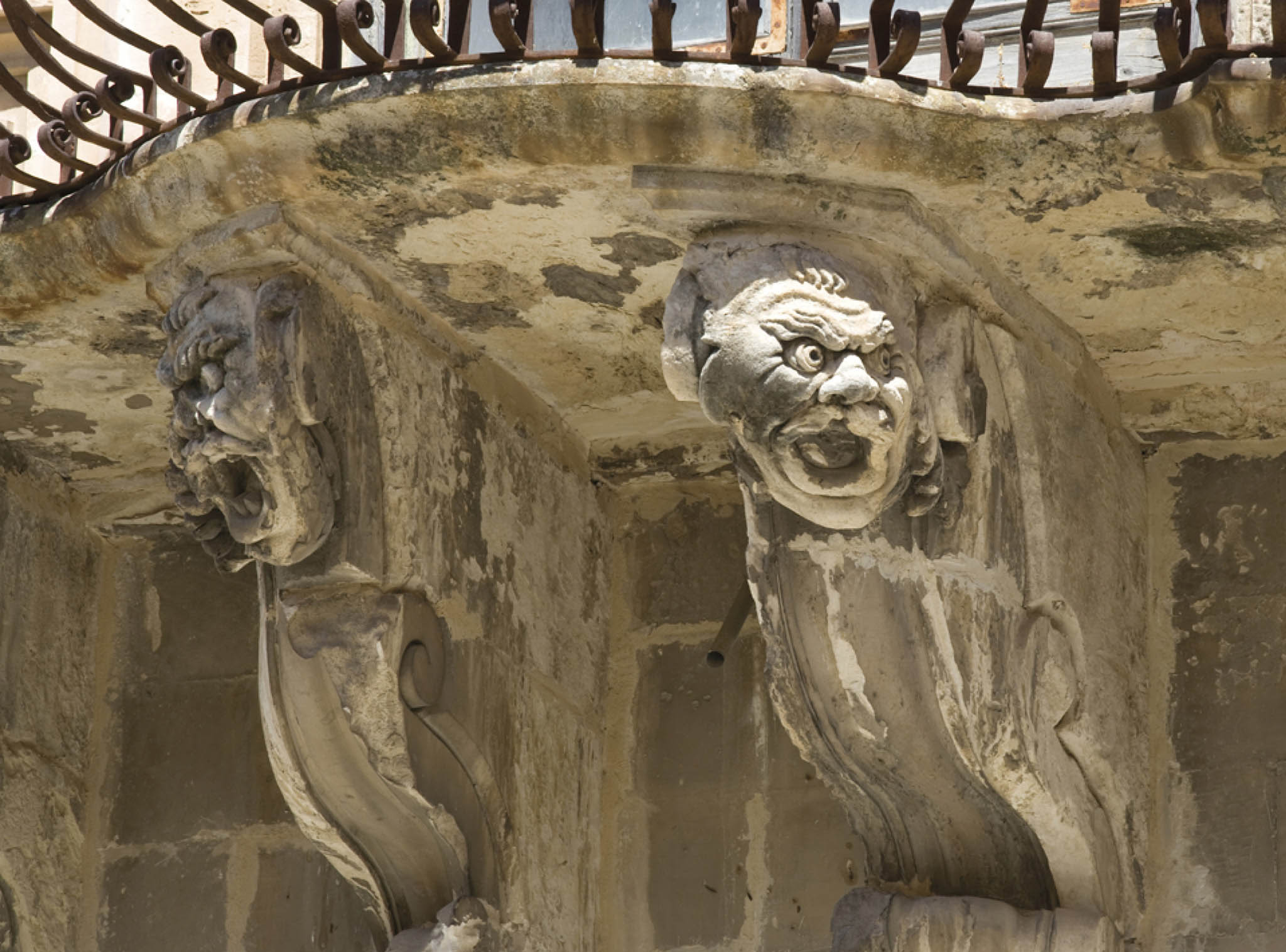
Ghoulishly decorated balcony of the Palazzo Beneventano, Scicli
Sampieri is a little summer resort that retains a few old stone fishermen’s houses, at the head of an unspoiled 4-km (2-mile) beach, dominated by the ecclesiastical-looking ruins of a 19th-century tuna processing plant. The fine walk along the beach here is taken by the artists of the Gruppo di Scicli every morning.
From Sampieri the coast road passes through Donnalucata, a pleasant fishing village and bustling resort with a long sandy beach. Further on is the Riserva Naturale Macchia Foresta Fiume Irminio, a coastal nature reserve with paths through bamboo, lentisk and giant thistles to sand dunes and designated swimming areas. Marina di Ragusa, at the turn off for Ragusa, is a lively resort with a good beach.
 Take SP65, which becomes SP64, then SP89, then SP63 to Marina di Ragusa. Turn right towards Ragusa on SP25. In Ragusa follow signs to Ibla. At the foot of the road that descends to Ibla there is an ample car park.
Take SP65, which becomes SP64, then SP89, then SP63 to Marina di Ragusa. Turn right towards Ragusa on SP25. In Ragusa follow signs to Ibla. At the foot of the road that descends to Ibla there is an ample car park.

Fishing boats at the head of the beach in Sampieri
Trip 22: Sicilian Baroque | MODICA
WHERE TO STAY
Modica
L’Orangerie moderate
Elegant rooms with frescoed ceilings in a mid-19th-century palazzo with courtyard garden. Vico de Naro 5, off Corso Umberto I, 97015; 3470 674 698; www.lorangerie.it
Hotel Cambiocavallo moderate
Minimalist design in a traditional farm- house between Modica and the sea. Contrada Zimmardo Superiore, 97015; 0932 951 727; www.cambiocavallo.it
Casa Talia expensive
Intimate, tasteful hotel in the old part of town with a lush garden. Via Exaudinos 1–9, off Corso Umberto I, 97015; 0932 752 075 or 335 548 6656; www.casatalia.it; closed Jan–Mar
Scicli
Hotel 900 moderate
Joyous bijou hotel with friendly staff and a collection of works by the Gruppo di Scicli. Fresh ricotta for breakfast. Via Duprè 11, 97018; 0932 843 817; www.hotel900.it
Trip 22: Sicilian Baroque | SCICLI
art in scicli
Tecnica Mista
A welcoming art gallery showcasing works of the Gruppo di Scicli. Vico Albertone 1, 97018; 0932 931 154; www.tecnicamista.it; open Tue–Sat, 10am–1pm & 4–8pm
Trip 22: Sicilian Baroque | MODICA
CHOCOLATE TASTING IN MODICA
Antica Dolceria Bonajuto
Founded in 1880, this shop offers free chocolate tastings any time and visits by appointment. Corso Umberto I 159, 97015; 0932 941 225; www.bonajuto.it
Caffè dell’Arte
The Lacono family have been making “glass chocolate” and pastries since 1967. If they are making chocolate in the little kitchen behind the bar it may be possible to take a look. Corso Umberto I 114, 97015; 0932 943 257; www.caffedellarte.it; closed Tue
Trip 22: Sicilian Baroque | SCICLI
Eat and Drink in Scicli
Ristorante Pomodoro moderate
Offers seasonal produce, and home-made bread, pasta and desserts. Corso Garibaldi 46, 97018; 0932 931 444; www.pomodoro-restaurant.it
Ragusa is a town with two distinct identities: Ragusa Superiore, a Baroque town laid out on a grid system over a mountain plateau; and Ragusa Ibla, also Baroque but rebuilt after the earthquake along the tangled streets of the old medieval town. Ibla, in particular, is undergoing a renaissance, with historic buildings being renovated and stylish hotels and restaurants opening. Though something of a museum town and lacking in everyday Sicilian town life, Ibla is undeniably gorgeous, and wandering its largely traffic-free streets, past the grand façades of golden limestone palaces and town houses, is like walking onto a film set.
The main Piazza del Duomo is dominated by the Duomo di San Giorgio (open daily), a lovely three-tiered Baroque wedding cake at the head of a flight of stairs. To its left is the Circolo di Conversazione (open daily, 10am–noon), a private club set in a sombre Neo-Classical building where the venerable burghers of Ibla still congregate. From Piazza del Duomo, Corso XXV Aprile, lined with shops selling typical Sicilian foods, leads down to the pretty public garden, Giardino Ibleo. Take a Navetta bus from here to Ragusa Superiore, to see the town’s second cathedral (open daily), and, close by on Via Roma, the Museo Archeologico Ibleo (open daily), with prehistoric, ancient Greek, Hellenistic and Roman finds. Before leaving Ragusa be sure to pick up a scacce, a kind of vegetable pie.
 Follow signs for Catania Agrigento. SP10, then SP8 to Chiaramonte Gulfi.
Follow signs for Catania Agrigento. SP10, then SP8 to Chiaramonte Gulfi.

Heraldic shield, Ragusa
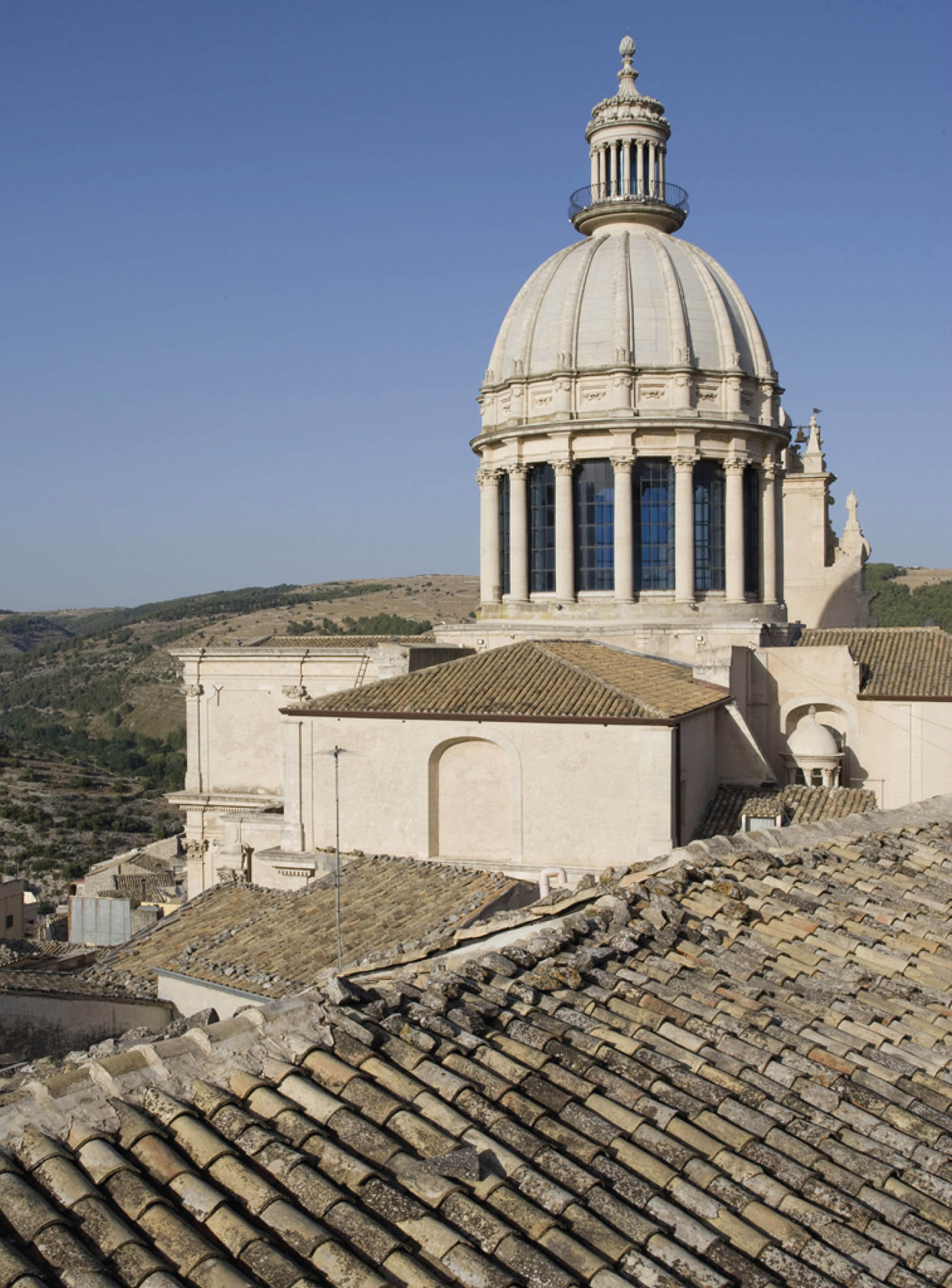
The elegantly proportioned dome of San Giorgio cathedral, Ragusa Ibla
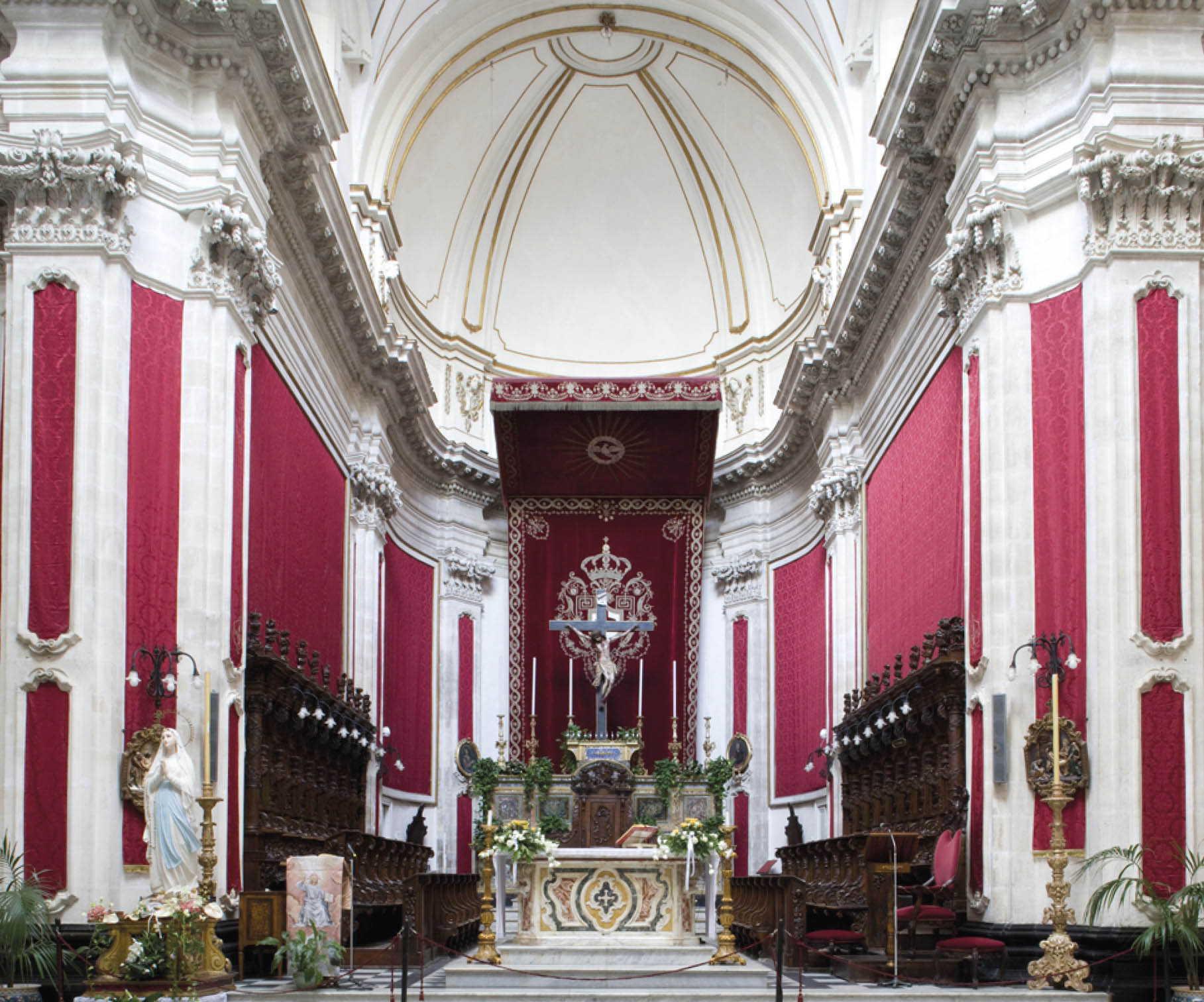
Pastel-hued front of the Circolo di Conversazione, Ragusa

Richly decorated interior of San Giorgio, Ragusa
The cobbled streets, palaces and churches of this handsome, well-kept town are all built of the same luminous silver-grey limestone. It retains its labyrinthine medieval street plan, along with a medieval arch, the Arco dell’Annunziata, one of the original town gates. The façade of the cathedral, Santa Maria Nova, (open daily) is currently undergoing renovation, but should soon be revealed in all its Baroque splendour. There are also several tiny museums (closed Mon), the most interesting devoted to olive oil, musical instruments and Stile Liberty, the Italian Art Nouveau. Each museum is signposted. From outside the Villa Comunale there are panoramic views down to the coast.
 Wind up the steep hill out of town following signs for Giarratana. Take the SP57, then the SP23 and the SP124 to Palazzolo Acreide.
Wind up the steep hill out of town following signs for Giarratana. Take the SP57, then the SP23 and the SP124 to Palazzolo Acreide.
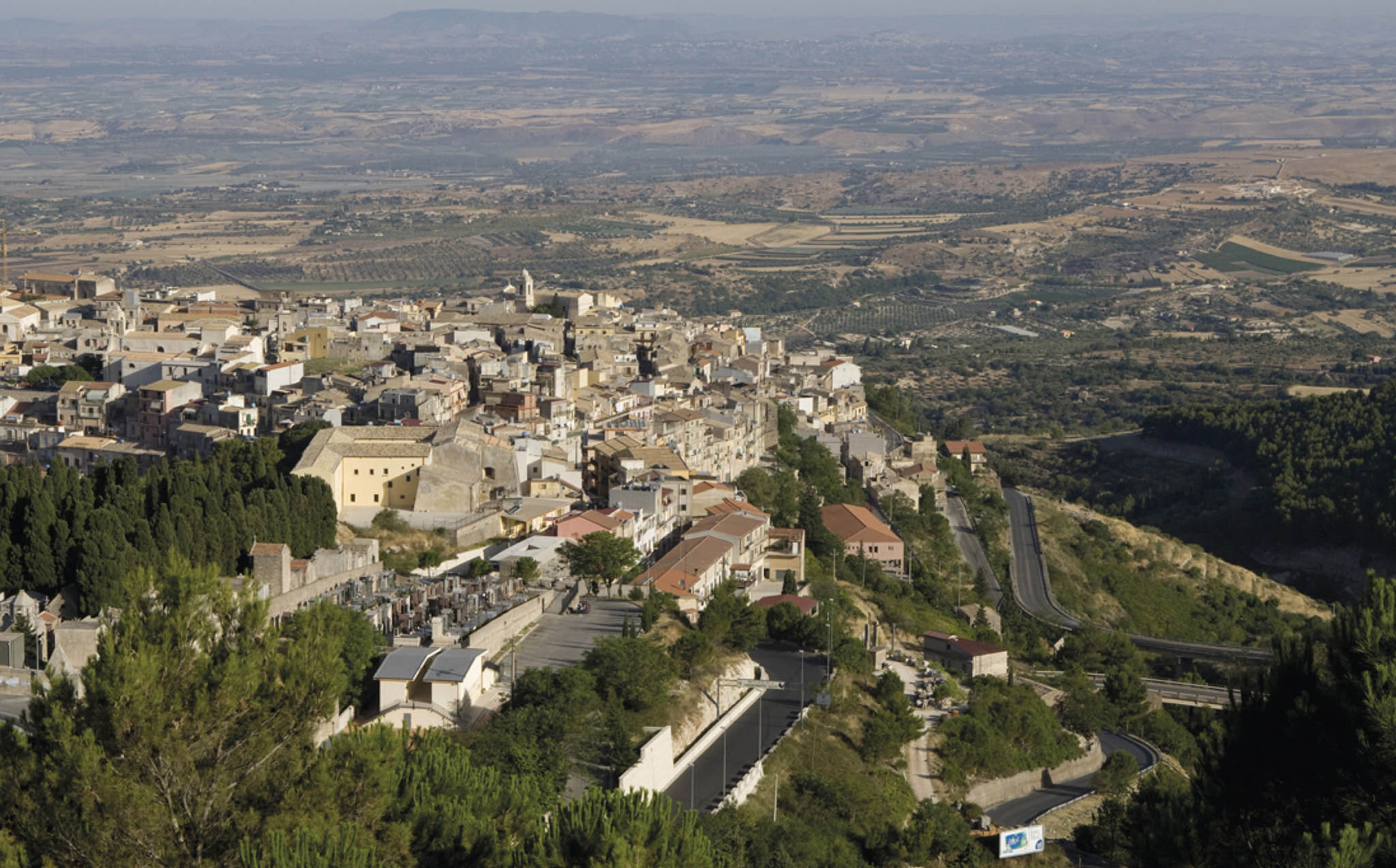
View of Chiaramonte Gulfi looking out to the distant coast
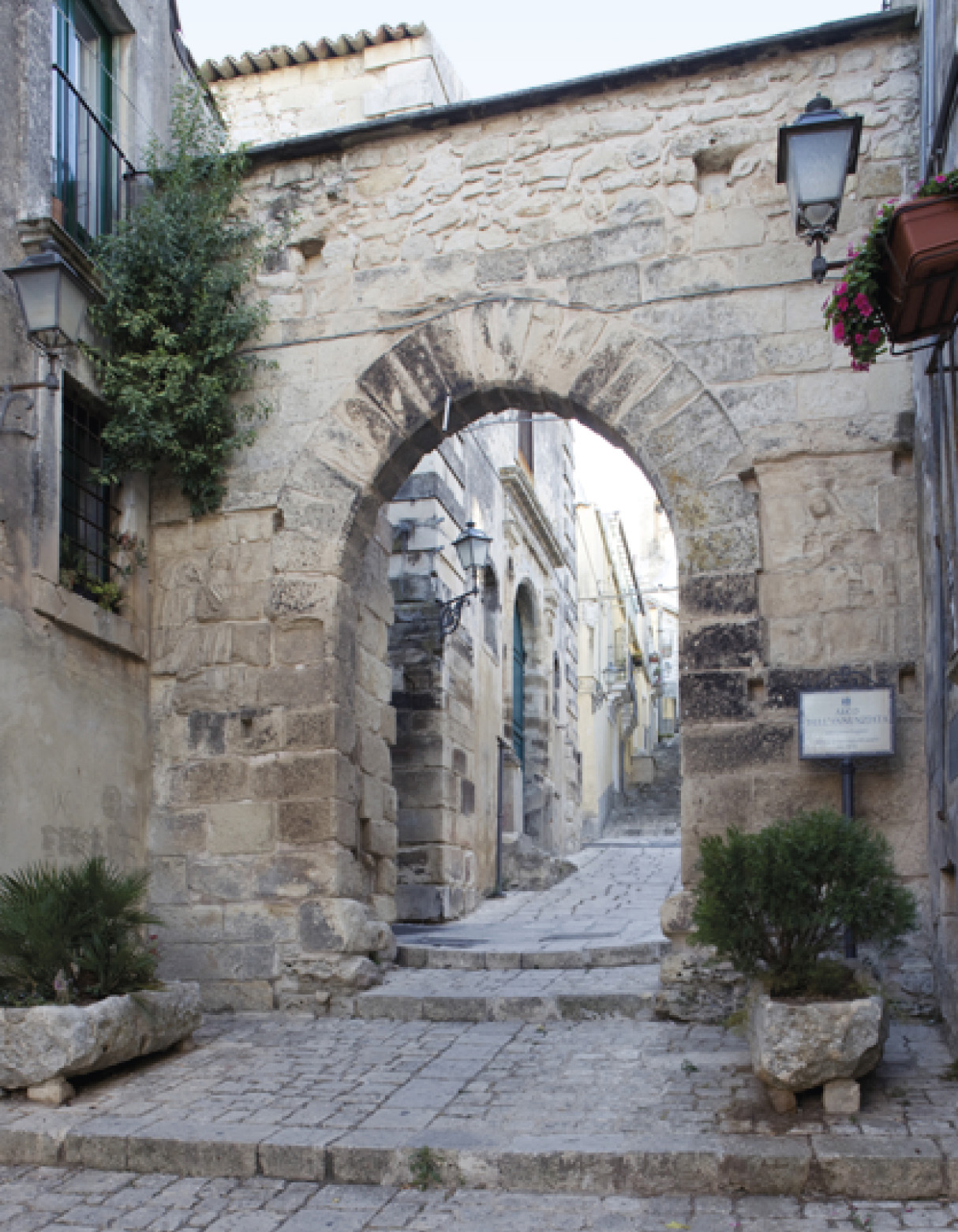
Well-preserved medieval Arco dell’Annunziata, Chiaramonte Gulfi
A slightly ramshackle Baroque town, whose roots go back to ancient Greek times, Palazzolo Acreide is currently undergoing a major facelift. Today, it is well worth a visit for its three striking Baroque churches: Santa Maria Addolorata, its façade adorned with barley sugar-twist columns, vines and acanthus leaves; the elegant, more restrained San Sebastiano; and San Paolo whose façade is currently concealed behind scaffolding. Also worth seeing is the Casa-Museo di Antonino Uccello (open daily), a glorious folk museum whose collections of wedding trousseaux, ceramics, agricultural equipment and reconstructed houses vividly evokes Sicily’s rural past. Above the town, the ruins of ancient Greek Akrei include a small but marvellously preserved theatre, which is still used for occasional performances. Do not leave Palazzolo without sampling a local speciality, impanata, a bread pasty similar to the scacce of Ragusa.
 Take the SS124 direction Siracusa, turning left at a sign to Ferla. Turn right at the old Ferla train station. Keep on going past Ferla, following the winding road along the upper ridge of the Pantalica gorge to the Filiporto Necropolis.
Take the SS124 direction Siracusa, turning left at a sign to Ferla. Turn right at the old Ferla train station. Keep on going past Ferla, following the winding road along the upper ridge of the Pantalica gorge to the Filiporto Necropolis.

Ancient Greek theatre in the Akrei ruins, Palazzolo Acreide
The limestone gorge of Pantalica, formed by the Bottigliera and Anapo rivers, is pitted with ancient rock-gouged tombs, dwelling places and temples, occupied from antiquity. The stronghold of the kingdom of Hybla, it was conquered by the Greeks in the 8th century BC. Many people from coastal communities escaped here from the invading Arabs, and some of the most evocative sites belong to this medieval period: cave-houses, a cave-chapel, preserving the hues of an ancient fresco, and even a cave-prison can all be seen at the Filiporto Necropolis, about 9 km (6 miles) from the village of Ferla.
 Retrace back to the SS124 and Palazzolo Acreide.
Retrace back to the SS124 and Palazzolo Acreide.
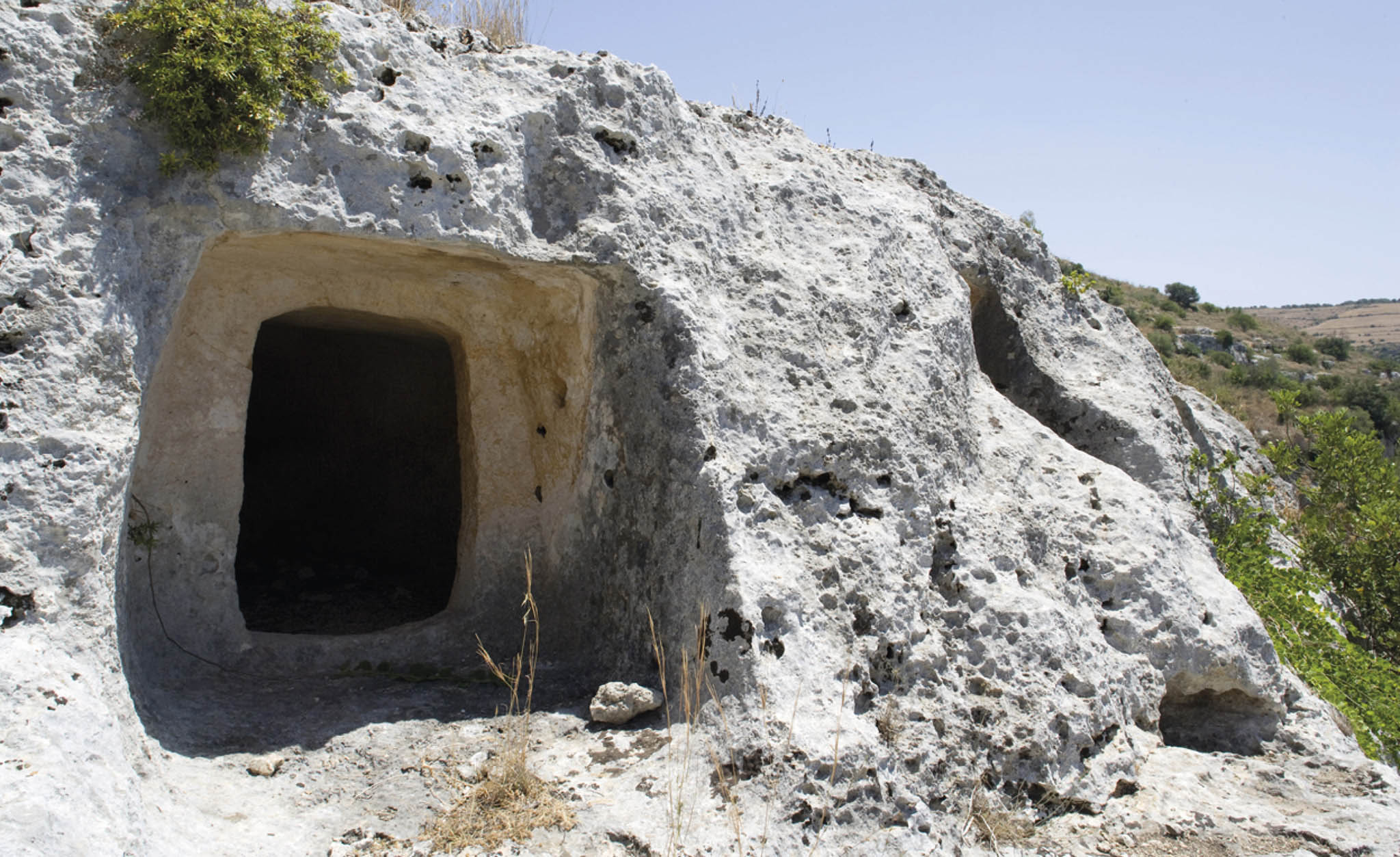
Entrance to a cave dwelling, Pantalica Gorge
Trip 22: Sicilian Baroque | RAGUSA
visiting ragusa
Tourist Information
AAPIT, Via Cap. Bacchieri 33 (Palazzo la Rocca), 0932 675 353; www.ragusaturismo.it; open Mon, Wed & Fri 9am–1:30pm, Tue & Thu 9am–1:30pm & 4–6pm
Trip 22: Sicilian Baroque | RAGUSA
WHERE TO STAY
Ragusa
Le Chicche inexpensive
Stylish little designer B&B with a great roof terrace, tucked behind the apse of Ibla’s Duomo. Via Salita Specula 7, Ibla; 97100; 330 849 862
Palazzolo Acreide
Anapama moderate
Three inviting apartments in a converted 19th-century house at the foot of the Anapo valley, surrounded by lush gardens, and with a swimming pool fed by a local spring. There are bikes for guest use and three horses available to ride. Contrada Fiumara, 96010; 0931 24011 or 331 786 2218; www.anapama.it
Trip 22: Sicilian Baroque | RAGUSA
EAT AND DRINK
Ragusa
Forno San Paolo inexpensive
Little bakery making excellent scacce – bread dough filled with spinach, cauliflower or aubergine. There is a bench outside, where you can sit for a picnic. Via Cascino Rosario, Modica, 97100; 0932 941 901
Locanda Don Serafino expensive
Justifiably renowned restaurant where diners eat under the romantically candlelit vaults of a historic palazzo. Via 11 Febbraio, 97100; 0932 220 065; www.locandadonserafino.it; closed Tue
chiaramonte gulfi
Ristorante Majore moderate
This restaurant specializes in all things pork. Wholesome, simple Italian cuisine in a beautiful setting. Via Martin Ungheresi 12, 97012; 0932 928 019; www.majore.it
PALAZZOLO ACREIDE
Bar San Paolo inexpensive
The best place to try impanata, a pasty made of crisp bread dough filled with vegetables such as broccoli, sundried tomatoes, chilli, potato and onion. Piazza Umberto, 96010; closed Mon
Trip 22: Sicilian Baroque | RAGUSA
Day trip options
To break up the tour into day trips Modica or Scicli offer a good base between the inland sights and sea.
By the seas
Spend a morning at the beach of Cala Mosche 2, star of the Golfo di Noto. Enjoy a fish lunch by the old tuna marina in Marzamemi 3, then head for the Capo delle Correnti 4 at the southern tip of Italy.
Access Riserva Vendicari at the Cala Mosche entrance. Turn off for Marzamemi before Pachino, then turn left on the SR6 and cross the SR8.
Cave life
Start in Palazzolo Acreide q (pack an impanata for lunch) and visit the caves of Necropoli di Pantalica w, then head south to Ispica 5 to discover more caves and catacombs.
Take SS124, then SS287 towards Noto. Then take the SP15 to pick up the A18 motorway, exiting at Rosolini for Ispica.
Baroque pearls
All the towns boast stunning Baroque gems but the unmissable three are Noto 1, Modica 6 and Ragusa 9, all off SS115 and feasibly seen in a day.
From the SS115, take the SS43 for Modica and the SP25 for Ragusa.
